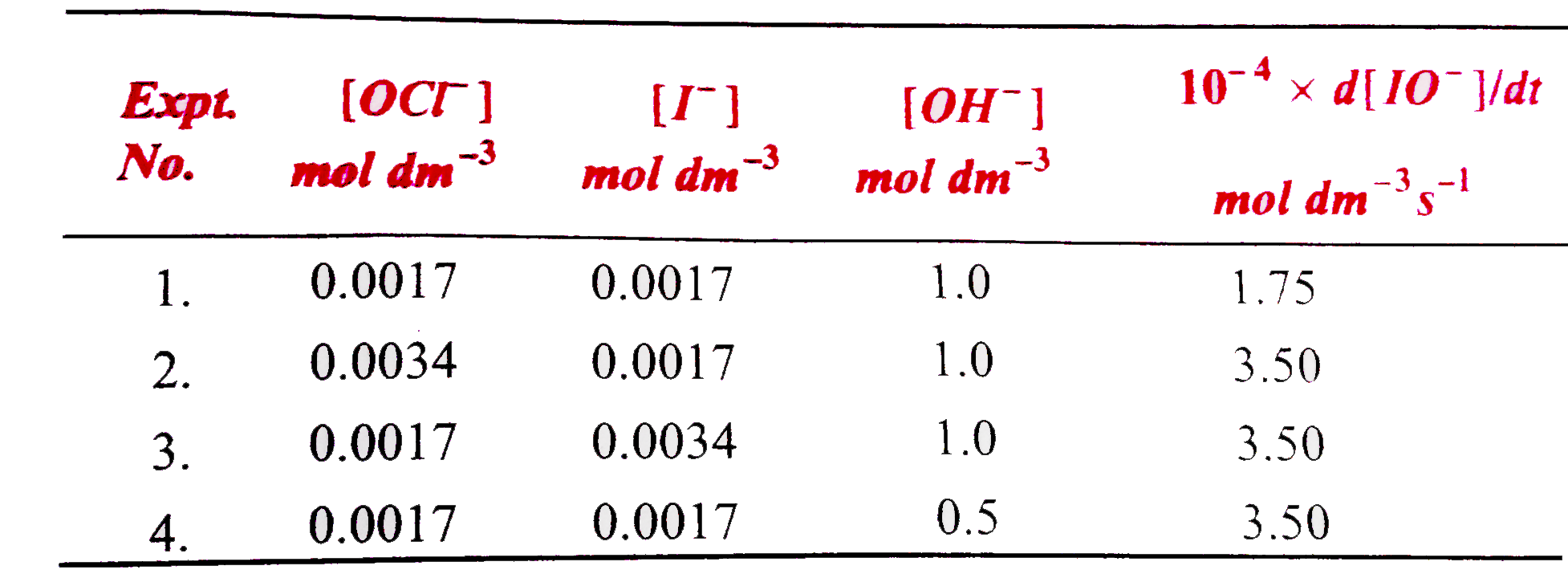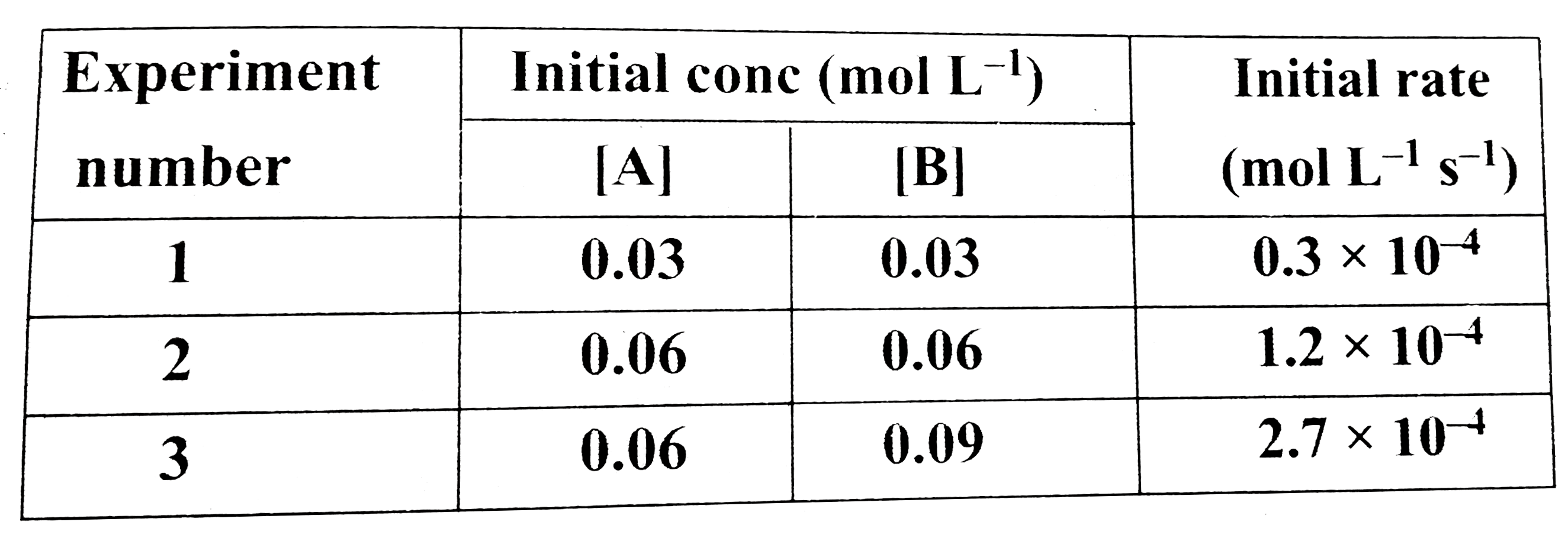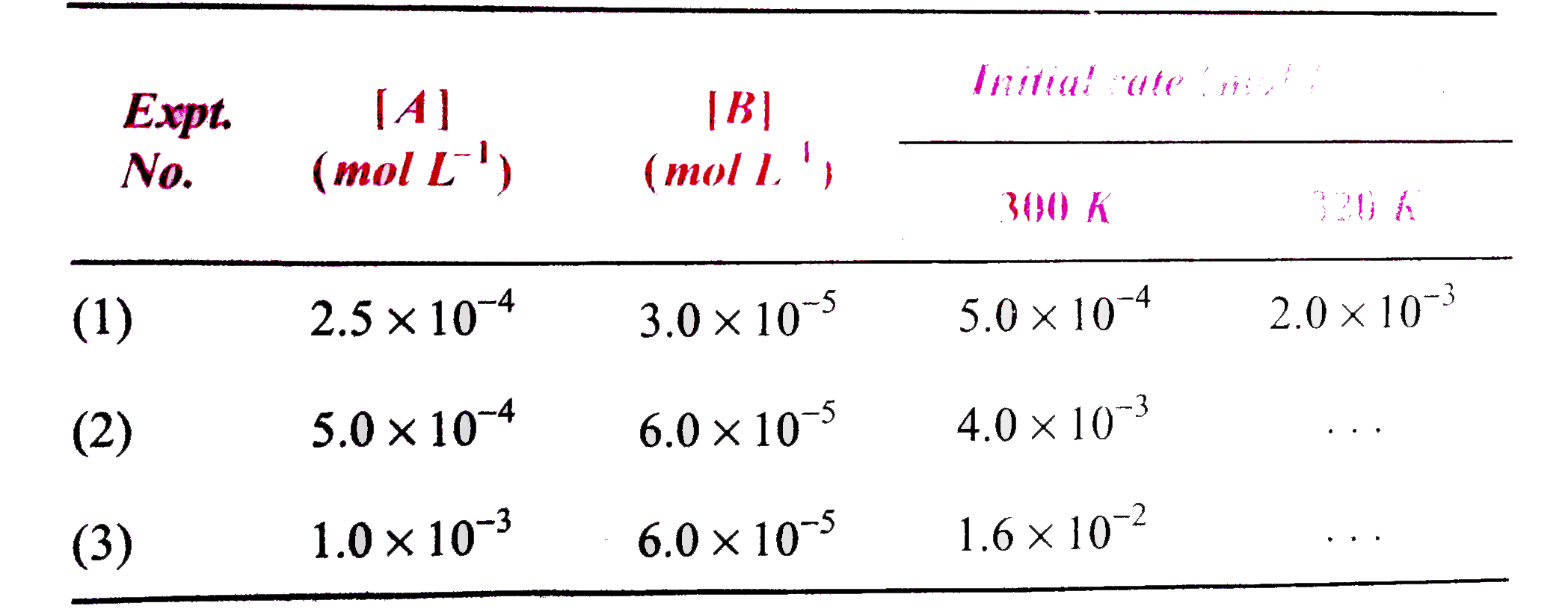Complete Solutions to EXAMPLE of chapter CHEMICAL KINETICS of Class 12 book with complete answers and questions
| Class 12 | CHEMISTRY |
| Chapter | CHEMICAL KINETICS |
| OP TANDON | EXAMPLE |
| Number Of Questions | 59 |
| Academic Year | 2023-24 |
In a reaction, the concentration of a reatant (A) changes from `0.200 "mol litre"^(-1) to 0.150 "mol litre"^(-1)` in 10 minutes. What is the average rate of reaction during this interval ?
01:43View SolutionDecomposition of `N_(2)O_(5)` is expressed by the equation ,
`N_(2)O_(5)rarr2NO_(2)+^(1//2)O_(2)`
If during a certain time interval, the rate of decomposition of `N_(2)O_(5) is 1.8xx10^(-3) "mol litre"^(-1) "min"^(-1)` , what will be the rates of formation of `MO_(2) and O_(2)` during the same intrval ?02:27View SolutionFor each of the following reactions, express the given rate of change of concentration of the reactants or Products in that reaction:
(a) `H_(2)O_(2) + 2H^(o+) + 3I^(ɵ) rarr I_(3)^(ɵ) + 2H_(2)O`, `(-d[I^(ɵ)])/(d t) = ?`, `(-d[H^(o+)])/(d t) ? `
(b) `16H^(o+) + 2MnO_(4)^(ɵ) + 10I^(ɵ) rarr 2Mn^(2+) + 8H_(2)O + 5I_(2)`, `(-d[MNO_(4)^(ɵ)])/(d t) = ?`
( c) `4NH_(3) + 5O_(2) rarr 4NO_(2) + 6H_(2)O` , `(-d[NH_(3)])/(d t) = ?`07:18View SolutionThe following reaction was carried out in water :
`Cl_(2) + 2I^(ɵ) rarr I_(2) + 2Cl^(ɵ)`
The initial concentration of `I^(ɵ)` was `0.25 mol L^(-1)` and the concentration after `10 min` was `0.23 mol L^(-1)`. Calculate the rate of disappearance of `I^(ɵ)` and rate of appearance of `I_(2)`.03:31View SolutionThe reaction between `Cr_(2)O_(7)^(2-) and HCO_(2)` in an acidic medium is :
`Cr_(2)O_(7)^(2)+5H^(+)+2HNO_(2)rarr2 Cr^(3+)+3NO_(3)^(-)+4H_(2)O`
The rate of disappearance of `Cr_(2)O+_(7)^(2-)` is found to be `2.4xx10^(-4)"mol" L^(-1)s^(-1)` during a meausred time interval. Find the rate of disppearanceo of `HNO_(2)` and the rate of appearance of `Cr^(3+)` during this time interval02:40View Solution4g of hydrogen and 128 g of hydrogen iodide are present in a 2litre flask. What are their active masses?
02:10View SolutionThe rate of reaction triples when temperature changes form `20^(@)C` to `50^(@)C`. Calculate the energy of activation for the reaction `(R= 8.314JK^(-1)mol^(-1))`.
02:30View SolutionIn Arrhenius equation for a certain reaction , the values of A and `E_(a)` (activation energy are `4xx10^(13) "sec"^(-1) and 98.6 kJ "mol"^(-1)` respectively. At what temeperatue, the reaction will have specific constant `1.1xx10^(-3) "sec"^(-1)`?
02:11View SolutionThe rate constant is given by Arrhenius equation.
`k=Ae^(-E_(a)//RT)`
Calculate the ratio of the catalysed and uncatalysed rate constants at `25^(@)C` if the energy of activation of a catalysed raction is 162 kJ and for the uncatalysed reaction the value is 350 kJ03:58View SolutionCalculate the rate constant of a reaction at 293 K when energy of activation is 103 kJ `"mol"^(-1)` and the rate constant at 273 K is `7.87xx10^(-7)s^(-1)`
`(R=8.314xx10^(-3)kJ"mol"^(-1)KJ^(-1))`02:24View SolutionAt 407 K, the rate contant of a chemical reaction is `9.5xx10^(-5) s^(-1)` and at 420 K the rate constant is `1.9xx10^(-4)s^(-1)`. Calculate the frequency equation is
03:28View SolutionThe energy of activation for a reaction is `100 KJ mol^(-1)`. The peresence of a catalyst lowers the energy of activation by `75%`. What will be the effect on the rate of reaction at `20^(@)C`, other things being equal?
07:47View SolutionThe experiment data for the reaction `2A + B_(2) rarr 2AB` is
`|{:("Experiment",[A] M,[B_(2)] M,"Initial rate" (mol L^(-1) s^(-1)),),(I,0.50,0.5,1.6 xx 10^(-4),),(II,0.50,1.0,3.2 xx 10^(-4),),(III,1.00,1.0,3.2 xx 10^(-4),):}|`
Write the most probable rate equation for the reacting giving reason for you answer.05:00View SolutionFor the reaction
`2NOrarr2NOCl`
at 300 K, following data are obtained:

Write rat law for the reaction. What is the order of the reaction? Also calculate the specific rate constant.05:07View SolutionFor the hypothetical reaction
`2A + B rarr` Products
following data obtained:
`|{:("Experiment number","Initial conc of (A)" (mol L^(-1)),"Initial conc of (B)" (mol L^(-1)),"Initial rate mol" L^(-1) s^(-1),),(1,0.10,0.20,3 xx 10^(2),),(2,0.30,0.40,3.6 xx 10^(10^(3)),),(3,0.30,0.80,1.44 xx 10^(4),),(4,0.10,0.40,...,),(5,0.20,0.60,...,),(6,0.30,1.20,...,):}|`
Find out how the rate of the reaction depends upon the concentration of `A` and `B` and fill in the blanks given in the table.08:18View SolutionThe table given below gives kinetic data for the following reaction at 298 K:
`OCl^(-)+I^(-)rarrOI^(-)+Cl^(-)`

What is the rate law and what is the value of rate constant?05:33View SolutionThe rate law for the reaction,
`2Cl_(2)Orarr2Cl_(2)+O_(2)`
at `200^(@)C` is found to be : rate = `k[Cl_(2)O]^(2)`
(a) How would the rate change if `[Cl_(2)O]` is reduced to one- third of its original value
(b) How should the `[Cl_(2)O]` be chabged in order to double the rate
(c) How would the rate change is `[Cl_(2)O]` is raised to threefold of its original value ?03:44View SolutionFor a reaction in which `A` and `B` form `C`, the following data were obtained from three experiments:

What is the rate equation of the reaction and what is the value of rate constant ?06:28View SolutionThe thermal decomposition of a compound is of first order. If `50%` of a sample of the compound is decomposed in 120 minutes, how long it take for `90%` of the compounds to decompose.
03:09View SolutionThe decompoistion of `Cl_(2)O_(7)` at `400 K` in gas phase to `Cl_(2)` and `O_(2)` is a first order reaction.
a. After `55 s` at `400 K`, the pressure of `Cl_(2)O_(7)` falls form `0.062` to `0.044 atm`. Calculate `k`.
b. Calculate the pressure of `Cl_(2)O_(7)` after `100 s` of decompoistion.04:26View SolutionCatalytic decomposition of nitrous oxide by gold at `900^(@)C` at an initial pressure of 200mm was `50%` in 53 minutes and `73%` in 100 minutes.
(a) What is theorder of reaction?
(b) How much it will decompose in 100 minutes at the same temperature but at an initial pressure of 600mm?03:56View SolutionA substance reacts according to `I` order kinetics and rate constant for the reaction is `1 xx 10^(-2) sec^(-1)`. If its initial concentration is `1M`.
(a) What is initial rate?
(b) What is rate after `I` minute ?03:17View SolutionA first order reaction is `50%` completed in `30 min` at `27^(@)C` and in `10 min` at `47^(@)C`. Calculate the reaction rate constants at `27^(@)C` and the energy of activation of the reaction in `kJ mol^(-1)`.
03:34View SolutionIn a Arrhenius equation for a certain reaction, the values of `A and E_(a)` ( energy of activation)are `4xx10^(13)s^(-1)` and `98.6KJ mol^(-1)`, respectively. If the reaction of first order at, what temperature will its life periof be `10 min`.
03:52View SolutionA second order reaction in which in both the reactants have same conentratio, is `20%` completed in 500 seconds. How much time it will take for `60%` completion?
02:27View SolutionThe decomposition of dinitrogen pentoxide `(N_(2)O_(5))` follows first order rate law. Calculate the rate constant from the given data:
`t=800sec[N_(2)O_(5)]=1.45 "mol"L^(-1)=[A_()]`
`t=1600 sec [N_(2)O_(5)]=0.88"mol"L^(-1)=[A_(2)]`01:38View SolutionThe decompasition `N_(2)O_(5)` acccording to the equation.
`N_(2)O_(5)rarr4NO_(2)(g)+O_(2)(g)`
is a first order reaction. After 30 minutes from the start of the decomposition is a closed vessel, the total pressure developed is found to be 284. 5 mm Hg and on completion the total pressure is 584.5mm Hg. Calculate the rate constant of the reaction04:09View SolutionThe gas phase decomposition of dimethyl ether follows first order kinetics.
`CH_(3)-O-CH_(3)(g)rarrCH_(4)(g)+H_(2)(g)+CO(g)`
The reaction is carried out in a constant volume container at `500^(@)C` and has a half life of `14.5 min`. Initially, only dimethyl ether is present at a pressure `0.40 atm`. What is the total pressure of the system after `12min`? (Assume ideal gas behaviour)04:25View SolutionThe half time of first order decomposition of nitramide is `2.1` hour at `15^(@)C`.
`NH_(2)NO_(2(aq.))rarr N_(2)O_((g))+H_(2)O_((l))`
If `6.2 g` of `NH_(2)NO_(2)` is allowed to decompose, calculate:
(i) Time taken for `NH_(2)NO_(2)` is decompose `99%`.
(ii) Volume of dry `N_(2)O` produced at this point measured at STP.05:42View SolutionFrom the following data for the reaction between A and B

Calculate the following
(i) The order of the reaction with respect to A and with respect to B
(ii) The rate constant at 300K
(iii) The energy of activation and
(iv) The pre-exponential factor.06:44View SolutionAt a certain temperature the half change periof for the catalystic decompoistion of ammonia was found as follows:
`|{:("Pressure (Pa)",6667,13333,26666),("Half life periof in hours",3.52,1.92,1.0):}|`
Calculate the order of reaction.04:19View SolutionOn heating orisine `(AsH_3))` decomposes as :
`2AsH_(3)(g)rarr2As(s)+3H_(2)(g)`
The total pressure measured at constant temperature and constant volume varies with time as follows:
`{:(t("min"),0,5,7.5,10),(p//mmHg,760,836,866.4,896.8):}`
Calculate the rate constant assuming the reaction to follow the first order rate law.05:32View SolutionCane sugar is gradualaly converted into dextrose and laevuloe by dilute acid. The rate of inversion is observed by measuring the polarisation angle, at various times, when the following results are obtained:
`{:("Time (min)",0,10,20,30,40,100,oo),("Angle",32.4,28.8,25.5,22.4,19.6,-6.1,-14.1):}`
Show that the reaction is of first order. Calculate the value of t, when the solution is optically inactive.04:31View Solution1 mL of methyl acetate was added to a flash containing 20 mL of N/20 HCl maintained at `25@C`. 2mL of the reaction mixture were withdrawn at different intervals and titrate with a standard alkali solution. The following results were obtained :
`{:("Time (min)",0,75,119,183,oo),("Alkali used (mL)",19.24,24.20,26.60,29.32,42.03):}`
show that the reaction follows first order kinetics03:34View SolutionThe gaseous decomposition of ozome
`2O_(3)rarr3O_(2)`
obeys the rate law `r=-(d[O_(3)])/(dt)=(k[O_(3)]^(2))/([O_(2)])`
Show that the following mechanims is consistent with the above rate law :
`O_(3)overset(K_(eq))hArrO_(2)+O" " ("fast")`
`O+O_(3)overset(k_(1))rarr2O_(2)" " ("slow")`03:17View SolutionFor the formation of phosgene from CO(g) and chlorine.
`CO(g)+Cl(g)rarr CoCl_(2)(g)`
the exermientally detrmined rate equation is,
`(d[COcl_(2)])/(dt)=k[CO][Cl_(2)]^(2//3)`
Is the following mechanism consistent with the rate equation
`{:((i),Cl_(2)hArr2Cl,("fast")),((ii),Cl+COhArrCOCl,("fast")),((iii),COCl+Cl_(2)hArrCOCl_(2)+Cl,("slow")):}`03:18View SolutionRate constant for the decomposition of ethylene oxide into `CH_(4)` and CO may be described be the equation. `logk(s)^(-1)=14.34-(1.25xx10^(4))/(T)`
(a) What is the energy of activation of this reaction ?
(b) What is the value of k at 670K ?02:42View SolutionA drug becomes ineffective after `30%` decompoistion. The original concentration of a sample was `5 mg mL^(-1)` which becomes `4.2 mg mL^(-1)` during `20` months. Assuming the decompoistion of first order, calculate the expiry time of the drug in month. What is the half life of the Product?
04:18View SolutionTwo reactions of the same order have equal exponential factors but their activation energies differ by `24.9 kj mol^(-1)`. Calcualte the ratio between the rate constants of these reactions at `27^(@)`C (Gas constant `R= 8.3 JK^(-1)mol^(-1))`
06:27View SolutionPseudo first order rate for the reaction
`A + B rarr P`
when studied in `0.1 M` of `B` is given by
`-(d[A])/(dt) = k[A]`
where `k = 1.85 xx 10^(4)s^(-1)`. Calculate the value of second order rate constant.02:54View SolutionThe time required for `10%` completion of a first order reaction at `298 K` is equal to that required for its `25%` completion at `308 K`. If the pre-exponential factor for the reaction is `3.56 xx 10^(9) s^(-1)`, calculate its rate constant at `318 K` and also the energy of activation.
07:54View SolutionThe rate constant of a reaction is `1.5 xx 10^(7)s^(-1)` at `50^(@)C` and `4.5 xx 10^(7) s^(-1)` at `100^(@)C`. Evaluate the Arrhenius parameters `A` and `E_(a)`.
04:11View SolutionIn hydrogenation reaction at `25^(@)C`, it is observed that hydrogen gas pressure falls from 2 atm to 1.2 atm isn 50 min. Calculate the rate of reaction in molarity per sec. (R=0.0821 litre -atm `"degree"^(-1) "mol"^(-1))`
03:10View SolutionA drop of solution (volume `0.05 mL`) contains `3 xx 10^(-6) "mole" H^(o+)` ions. If the rate constant of disappearance of `H^(o+)` ions is `1 xx 10^(7) mol L^(-1) s^(-1)`, how long would it take for `H^(o+)` ions in the drop of disappear?
02:45View Solution`2X(g) rarr 3Y(g)+2Z(g)`
`{:("Time (in min)",0,100,200,):}`
`|{:("Partial pressure of X (mm Hg)",800,400,200,),("Assuming ideal gas condition, calculate",,,,):}|`
(a) Order of reaction
(b) Rate constant
( c) Time taken for `75%` completion of reaction
(d) Total pressure when `p_(x) = 700 mm`05:23View SolutionSuppose 50 bacteria are placed in a flask contining nutrients for the bacteria so that they can multiply.
A study at `35^(@)C` gave the following results.:
`{:("Time (minute)",0,15,30,45,60),("Number of bacteria" ,50,100,200,400,800):}`
Show that the rate of productin of bacteria is of first order. How many bacteria wil be there after 3 hours?03:13View SolutionA viral preparation was inactivated in a chemical both. The inactivation process was found to be of first order is virus concentration, and at the beaginning of the minutes. Evaluate 'k' the inactivation process.
01:42View SolutionTrans `1,2`-dideuterocyclopropane `(A)` undergoes a first order decompoistion. The observed rate constant at a certain temperature, measured in terms of disapperance of `A` was `1.52xx10^(-4)s^(-1)`. The analyiss of Products shwoed that the reaction followed two parallel paths, one leading to dideuteropropane `(B)` and the other to cis-`1,2`-dideuterocyclopropane `(c )`. `(B)` was found to constitute `11.2%` of the reaction Product, independently of the extent of reaction. What is the order of reaction for each path and what is the value of the rate constant for the formation of each of the Products ?
04:07View SolutionIn milk at `37^(@)C` , lactobalicillus acidophilus has a generation time of about 75 minutes . Calculate the population relative to the initial value at 30,60,75,and 150 minutes
02:59View SolutionRate law for ozone layer depletion is,
`(d[O_(3)])/(dt)=(K[O_(3)]^(2))/([O_(2)])`
Give the proboble mechanism of reaction ?02:30View SolutionIn hypothetical reaction, `A_(2)+B_(2)rarr2AB`, follows the follows the mechnism as given below :
`{:(A_(2)hArrA+A,("fast reaction")),(A+B_(2)rarrAB+B,("slow reaction")),(A+BrarrAB,("fast reaction")):}`
Give the rate law and order of reaction02:09View SolutionCalculate the order of reaction form the following data:
`2NH_(3) rarr N_(2) + 3H_(2)` (reaction)
`|{:("Pressure (mm Hg)",50,100,200),("Half lives (min)",3.52,1.82,0.93):}|`03:52View SolutionThe rate constant of the reaction `ArarrB` is k=0.5 , the initial concentration of A being 1 mol/litre. Calculate the degree of conversion of substance 'A' within1 hour if the reaction is of zeroth, first and second order. How does the degree of conversion depne on the order of reaction?
02:53View SolutionTwo first order reactions proceed at `25^(@)C` at the same rate. The temperature coefficient of the rate of the first reaction is `2` and that of second reaction is `3`. Find the ratio of the rates of these reactions at `75^(@)C`.
05:37View SolutionThe reaction `A+OH^(-)rarr` Products, obeys rate law expression as :
`(-d[A])/(dt)=k[A][OH^(-\)]`
If initial concentrations of [A] and `[OH^(-)]` are 0.02 M and 0.3 M respectively and if it takes 30 sec for `1%` A to react at `25^(@)C`, caclutate the rate constant for the reaction02:26View SolutionA hydrogenation reaction is carried out at `500 K`. If the same reaction is carried out in the presence of a catalyst at the same rate, the temperature required is `400 K`. Calculate the activation energy of the reaction if the catalyst lowers the activation barrier by `20 kJ mol^(-1)`.
06:27View SolutionSome `PH_(3)(g)` is introduced into a flask at `600^(@)C` containing an intert gas. `PH_(3)` proceeds to decompose into `P_(4)(g) and H_(2)(g)` and the reaction goes to complection. Total pressure is given below as a fucntion of time. Find the order of the reaction and calcualate the rate constant. `{:("Time (sec)",0,60,120,oo),("Pressure (mm Hg)",262.40,272.90,275.51,276.51):}`
06:37View SolutionFor the given reaction, `A+B rarr` Products following data were obtained

(i) Write the rate law expression.
(ii) Find the rate constant.03:30View SolutionThe rate law of a chemical reaction given below:
`2NO+O_(2)rarr 2NO_(2)`
is given as rate `=K[NO]^(2)[O_(2)]`. How will the rate of reaction change if the volume of reaction vessel is reduced to `1//4th` of its original valur?02:57View Solution
EXAMPLE questions and complete solutions for chapter CHEMICAL KINETICS of G.R. BATHLA & SONS CHEMISTRY (HINGLISH) of Class 12
All Exercises from OP TANDON Class 12 CHEMISTRY CHEMICAL KINETICS
- ASSERTION- REASON TYPE QUESTIONS
- EXAMPLE
- ILLUSTRATIONS
- INTEGER ANSWER TYPE QUESTIONS
- INTEGER ANSWER TYPE QUESTIONS (SECTIN-V)
- LINKED COMPRESHENSION TYPE QUESTIONS ( SECTION-VI)
- MATRIX -MATCHING TYPE QUESTIONS (SECTION-IV)
- MATRIX MATCHING TYPE QUESTIONS
- OBJECTIVE QUESTIONS (LEVEL-A)
- OBJECTIVE QUESTIONS (LEVEL-B) SET I
- OBJECTIVE QUESTIONS (LEVEL-B) SET II
- PASSAGE -1
- PASSAGE -2
- PASSAGE -3
- PASSAGE -4
- PASSAGE -5
- PRACTICE PROBLEMS
- SELF ASSESSMENT (SECTION-I)
- SELF ASSESSMENT (SECTION-II)
